
Amazon Ads Placement: How to Improve Your ROI
Author:
Neha Bhuchar
Last Updated:
Sep 24, 2025
Category:
Published on:

Table of Contents
Amazon is a competitive marketplace with millions of products vying for customers’ attention. Amazon advertising is crucial for standing out, but simply running an ad does not suffice. Research shows that 70% of Amazon shoppers never scroll past the first page. However, an effective and well-thought-out Amazon ads placement strategy can give you a significant edge, even in highly saturated categories.
Ad placements provide targeting options for customers in different buying processes, which boosts advertising ROI and snowballs sales success. However, this isn’t a one-size-fits-all approach—top of search ads drive high visibility, while product details page ads help brands capture shoppers further down the buying funnel. Therefore, it is important to understand the goal of your advertising campaign, whether you want to boost brand awareness and page visits, drive impulse purchases, or retarget potential buyers to achieve success.
In this blog, we will cover:
What are Amazon ad placements?
Amazon Sponsored Products Ad Placement
Amazon Sponsored Brand Ad Placement
Amazon Sponsored Display Ads Placement
Which advertising option is the best for you?
Strategies to develop effective ad placements
What are Amazon Ad Placements?
Ad placements determine where your ads appear within Amazon’s ecosystem. It ensures that your ads are found at the right place at the right time, influencing buying decisions and overall campaign performance.
Amazon offers several options for Amazon digital ad placement: product detail pages, search results, and competitor listings. Depending on their location, these ads can affect your visibility, click-through rate (CTR), and conversion rate (CVR)--key metrics that influence your advertising success. Therefore, understanding how ad placements work can help you allocate budgets, optimize bids, and improve overall ad performance.
What is Amazon Sponsored Products Ad Placement?
Amazon sponsored products ad placement is a pay-per-click (PPC) advertising solution that promotes individual product listings on the platform. Like any other PPC advertising option, you only pay for the ads when a customer clicks on them, providing maximum control over your budget and bids.
Sponsored product ads are only available to professional sellers, retail vendors, and Kindle Direct Publishing authors. Amazon allows them to promote products to customers searching for specific keywords or viewing similar products as their own.
This is one of the most widely used ad types, as it is an insight-driven solution for new and established advertisers. It’s also a cost-effective ad placement because, using the Amazon Ads Console, you can adjust those budgets and bids in real time. Additionally, this ad type helps promote your products, increases sales, and improves brand visibility.
Sponsored product ads often blend in with organic search results and are available in three different types:
Top of search
Rest of search
Product detail pages
Top of Search Ad Placement

The top of search placement ads are the first thing customers see when they initiate a search for a specific product. Since these ads appear on the first page of Amazon SERP, they are the most coveted and profitable placement for Amazon sellers. In fact, research shows that 32% of shoppers buy the first product listed on Amazon SERP.
This type of product placement is highly effective for capturing high-intent shoppers. Additionally, it helps build a strong, positive brand awareness, as the prime location conveys that the product is of high quality and relevance.
Since this is prime real estate, sellers bid high on competitive keywords, which increases the cost-per-click rates compared to other ad placements. Furthermore, to maintain this top position once secured, you need a well-thought-out keyword strategy; otherwise, you risk wasting your ad budget.
Rest of Search Ad Placement

The rest of the search placement ads are displayed alongside the organic search results in the middle and bottom of the first page and on subsequent search result pages. Generally, the lower your bid, the further your ads appear from the first SERP. This placement works well for sellers who specialize in a unique and niche product or who have a product that has high organic rankings.
Even though it has a lower click-through rate compared to top of search placement, this placement proves to be a cost-effective option due to the lower cost-per-click. Additionally, the rest of the search placement has a visibility advantage, as it captures customers who prefer scrolling down for more options.
Product Detail Page Ad Placement

The product detail page placement places ads in non-search placements like the add-to-cart page or product listing below the bullet-point section, and before and after the A+ content in the individual product pages. They are product-targeted ads that help attract competitors’ customers.
The click-through rate (CTR) for product detail pages is way behind the rates seen for top-of-search placements. However, this is a cost-effective option that can be extremely valuable if used strategically.
For example, if a shopper searching for a scented candle clicked on a product listing. Just before they hit the buy button, they can spot your product with better features like a lower price, better scent, higher burning time, etc mentioned in your product title. There is a higher chance that the customer will click on your listing and purchase your product.
The CTR and CVR differ for all three sponsored product ad placements, as you can see in the table below:
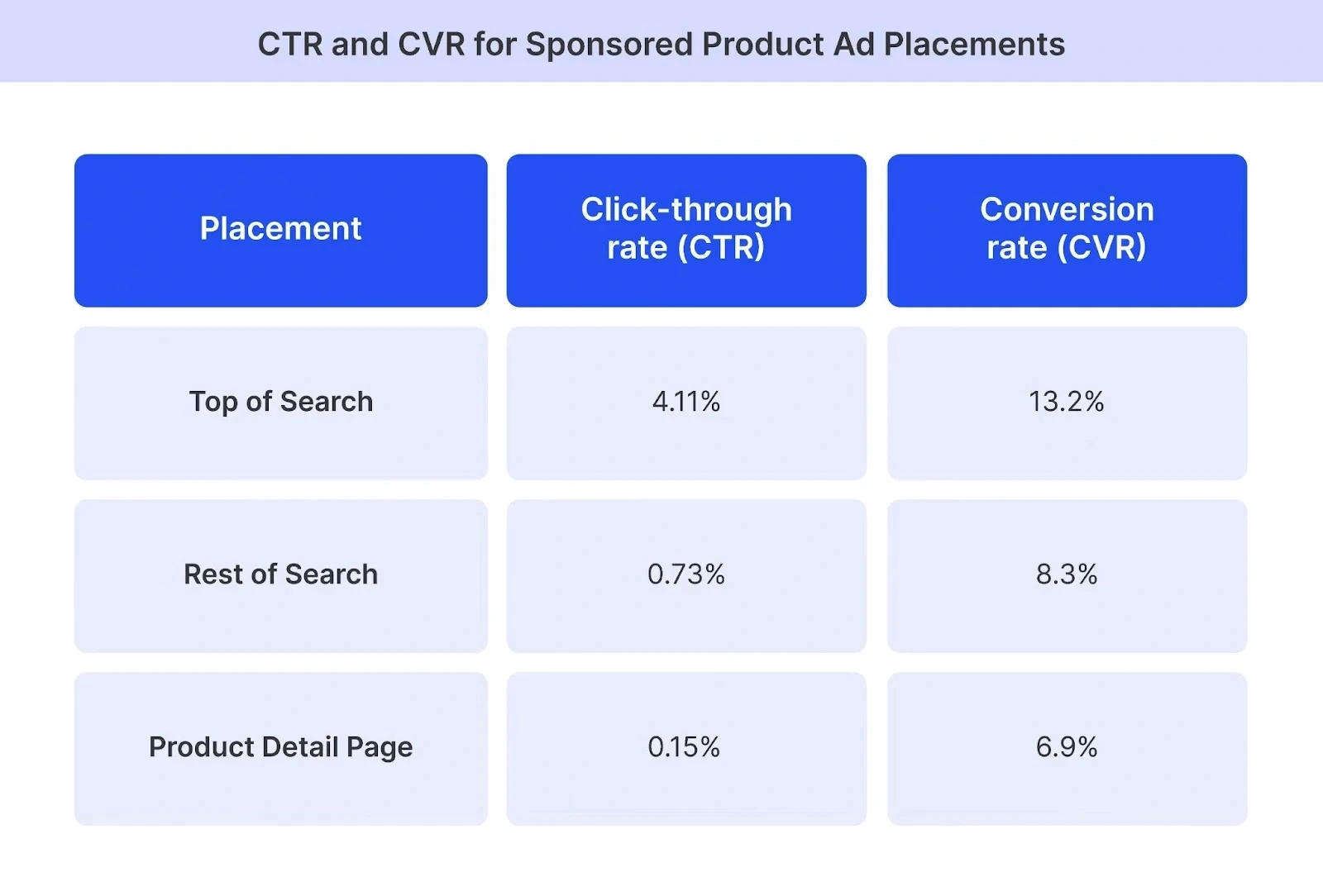
What are Sponsored Brand ad placements?
Sponsored brand ad placements are pay-per-click advertisements that appear on Amazon SERP. They feature a brand logo, a custom headline, and a few products to maximize customer exposure.
Once a customer clicks on the advertisement, they are directed to a storefront or a curated product collection, which can be used to offer a creative and branded experience. This unique style helps you increase brand awareness and sales on the platform, while also promoting multiple products at once.
Amazon allows professional sellers and retail vendors enrolled in Amazon brand registry to use this placement to advertise new products.
The sponsored brand ad placement is available in three different formats:
Product collection
Store spotlight
Video ads
Product Collection
The product collection ad placement allows you to display three products on the ad banner along with a custom link to your Amazon store or a dedicated landing page. It is generally seen on top of the search and the search footer of Amazon SERP.
Tip: Narrow down to specific subcategories of your product for the product collection banner to maximize conversion rate.
Store Spotlight

The store spotlight ads are also displayed on top of the search and the search footer of Amazon search results. The difference between store spotlight and product collection is that the former features the entire store as opposed to individual products. Additionally, the customer traffic is diverted to Amazon’s storefront, which is devoid of all competition.
Video Ads

Video ads are similar to sponsored product ads, as they advertise only one product with a link to the product listing. However, the engaging feature is the use of a video to showcase your product and its features to customers, which gives it a higher CTR than sponsored brands ads.
What are Amazon Sponsored Display Ads placements?
Amazon sponsored display ads placements are a self-service solution that helps you reach relevant audiences throughout their purchasing journey, both on and off Amazon.
Such placement can be used as a retargeting tool to re-engage potential customers who have previously viewed their product listing within the past 30 days. Additionally, it can also be used to expand reach through customized targeting based on customer’s previous shopping habits and interests.
Amazon offers two types of targeting options:
Interest-based targeting
As the name suggests, this involves targeting customers based on their broader interests such as browsing related products, shopping behaviors, similar categories, etc. It helps you tap into a wider audience and build brand recognition.
For example, if you sell fitness supplements, then you can target customers who buy fitness-related products like a black running shoe, protein powder, gym equipment, or healthy snacks. This helps you reach customers who are buying complementary products to your own product.
Product-based targeting

With this type of targeting, you target customers who buy similar, complementary, or competitor products on the platform. This is a useful tactic if you are looking to eat away at your competitor’s sales or promote a product as an add-on purchase.
Amazon sponsored display ads placements appear on product detail pages on Amazon desktop and mobile and customer review pages. It is also displayed via Amazon Publisher Services (APS), on third-party websites and apps like Twitch, Buzzfeed, and ESPN.
| Related read: Amazon Launches Ads on Prime Video: What You Need to Know
Which advertising option is best for you?
The best advertising option depends on your brand and campaign goals and where your customers are in the shopping journey. As mentioned before, Amazon ads placement is not a one-size-fits-all approach. Therefore, a deeper understanding of your products and customers helps you maximize ad performance and drive profitable growth.
For example, a company looking to enhance brand awareness should focus on sponsored products and sponsored brand ads. On the other hand, for companies that want to retain previous customers and drive repeat purchases, the best way is to use sponsored display ads and monitor the repeat buyers metric to see how well those campaigns re-engage past purchasers.
One way to simplify the process is through the traditional advertising funnel.
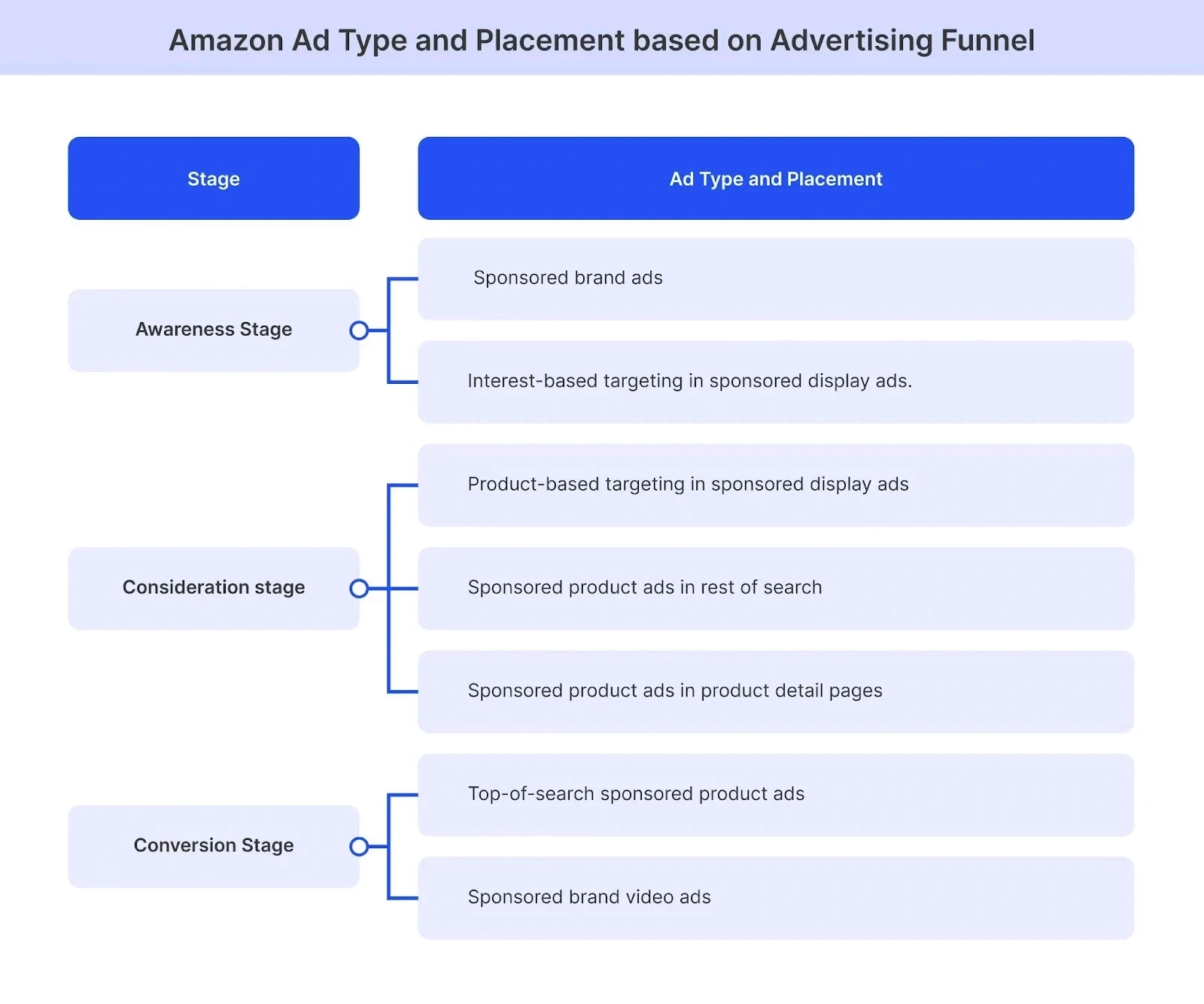
Top of the funnel
The top of the funnel is the awareness stage, which requires sellers to introduce their brands and attract new customers.
Recommended ad placement: Sponsored brand ads and interest-based targeting in sponsored display ads.
Middle of the funnel
Also known as the consideration stage, your buyers here are comparing your products with competitors and researching options.
Recommended ad placement: Product-based targeting in sponsored display ads and rest of search and product detail page in sponsored product ads.
Bottom of the funnel
The bottom of the funnel is the conversion stage where you want to target high-intent shoppers who are ready to buy your products.
Recommended ad placement: Top-of-search sponsored product ads and sponsored brand video ads.
How can you place Amazon ads effectively?
Amazon ad placements can be optimized by setting clear goals aligned with the product life cycle, targeting high-intent keywords, and enhancing product listings with relevant content. Use placement multipliers and dynamic bidding strategies, supported by tools like atom11’s bid calculator, to adjust bids based on conversion likelihood. Continuously track key metrics such as CTR, CVR, ACoS, and TACoS, leveraging data from Amazon Marketing Cloud and atom11’s dashboard to refine targeting and ensure efficient, goal-driven ad spend.
Amazon ads placement can be effectively developed, keeping in mind these strategies that drive profitability, generate sales, and maximize ROI on ad spend :
Set your Amazon ads placement goals
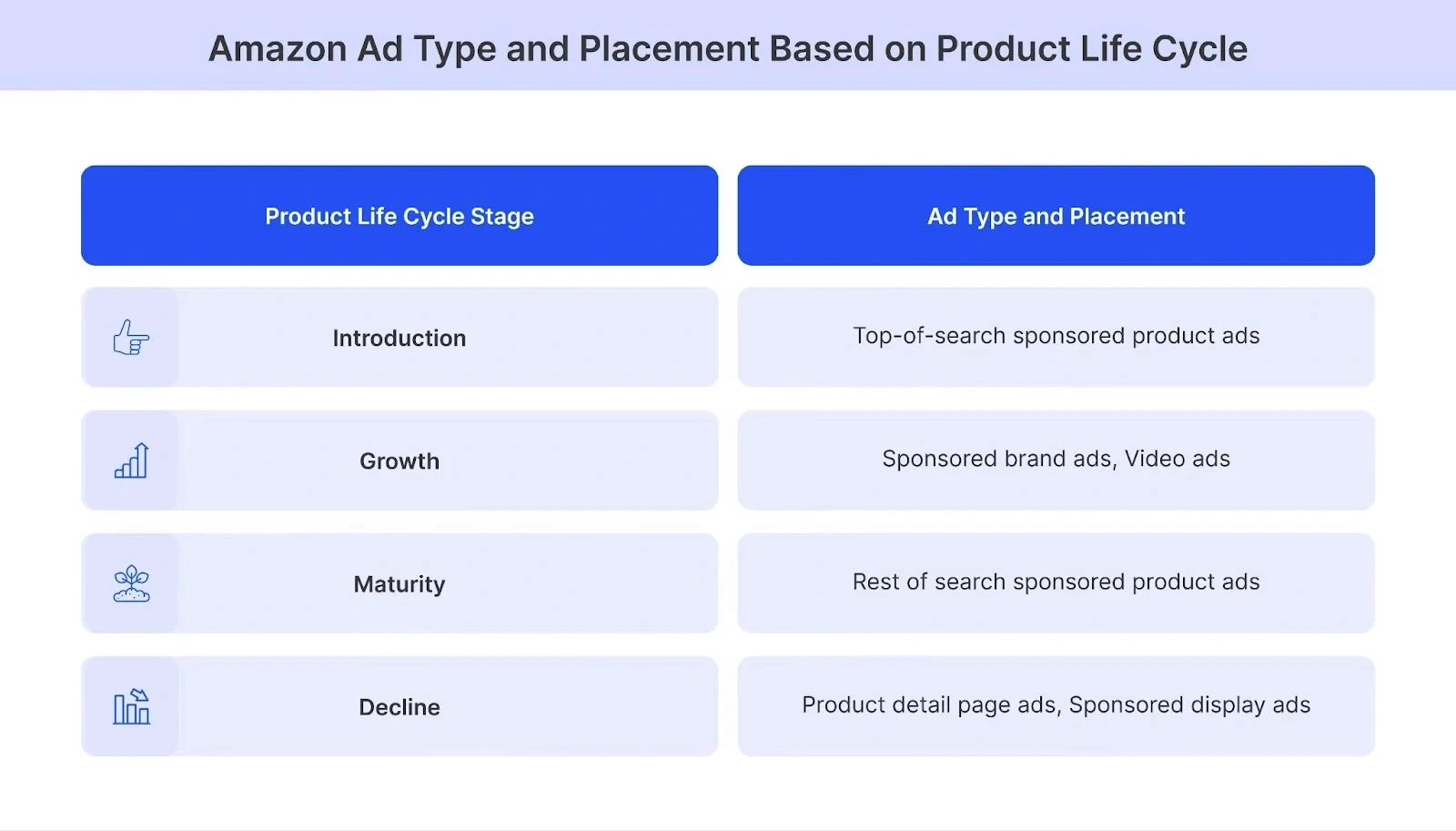
Before diving into ad placements, it is vital to define your goals. Do you want to maximize visibility, drive conversions or improve organic rankings? Each of these placement goals requires a different strategy. Defining your goals that align with the campaign type is the first step. For instance, if you want to cross-sell your products or target your competitor’s market, product detail page ad placement can help you.
Furthermore, your Amazon digital ad placement should evolve based on the product life cycle. A newly launched product will require aggressive top-of-search placements for initial traction. As the product moves to the established stage with steady organic sales, you can benefit from a balance of mixed ad placements.
Setting clear objectives will ensure your ad placements move hand-in-hand with your advertising strategy while maximizing returns and maintaining efficiency.
Perform Keyword Research and Optimize Product Listings
The success of your placement is dictated by target keywords, as they influence the cost of your advertising.
As we know, high-intent keywords are essential for Amazon ads. Therefore, conduct thorough research to find your high-intent keywords and negate trivial ones. It will help your product appear in relevant shopping results and on the right product pages, improving your overall placement performance.
Additionally, optimize your product listings with relevant keywords. Well-crafted titles, bullet points, informative product descriptions, and A+ content increase conversions, making placements more cost-effective.
While all of it is beneficial, manual keyword optimization can take a lot of time. Luckily, atom11’s search term harvester and negator feature allows greater control over keyword optimization.
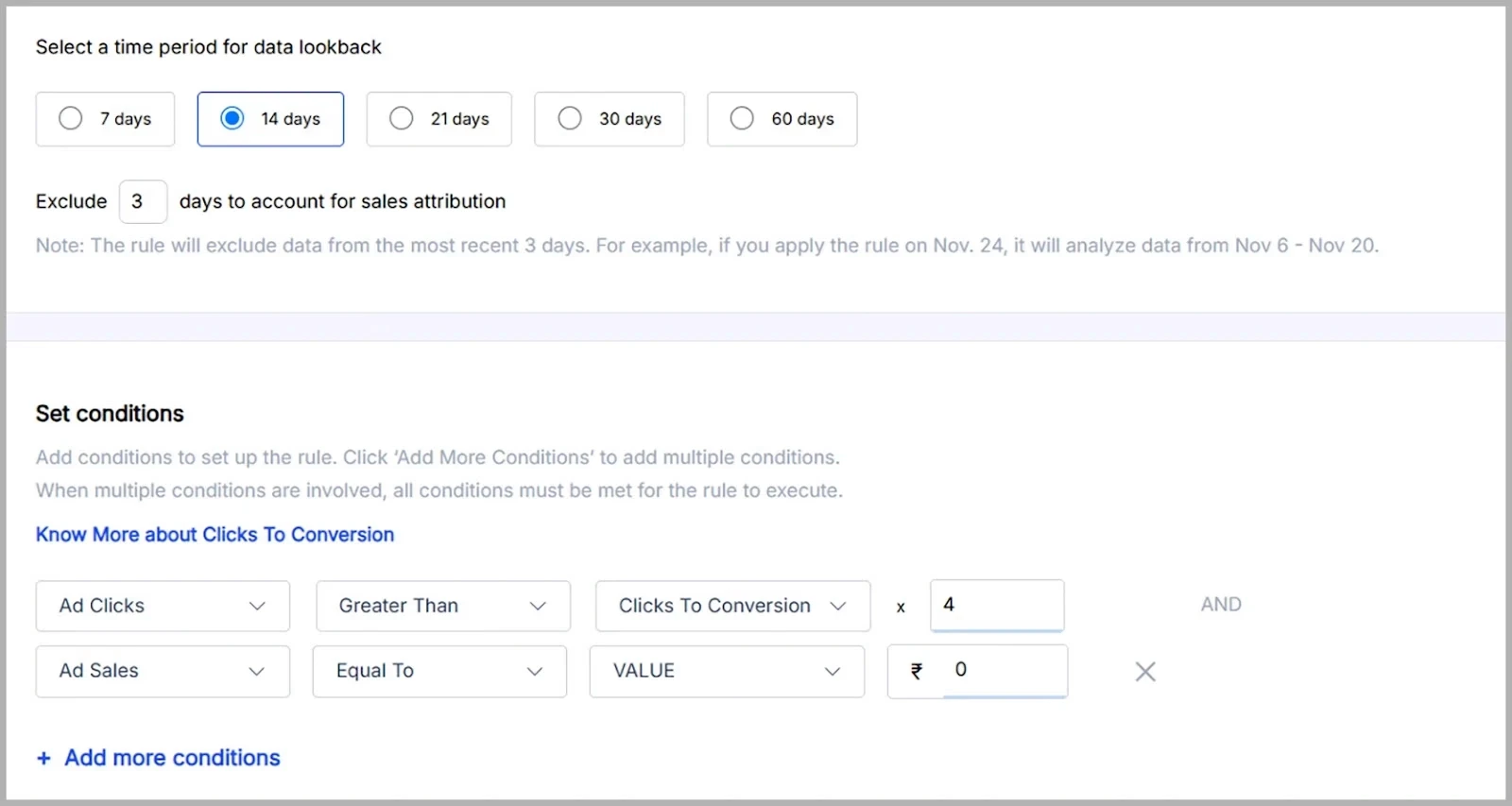
It can help you create custom rules to harvest high-performing keywords, negate non-performing keywords, and adjust campaigns and bids to your preference.
Leverage placement multipliers
Each placement has its unique advantages and disadvantages. Search placement bid modifiers or placement multipliers is a tool that allows you to adjust bids for different Amazon ads placement. You can pair those multipliers with dayparting—raising or lowering bids by time-of-day—to capture shoppers when purchase intent peaks. Available only for sponsored product ad placements and sponsored brand placements, these modifiers help you prioritize high-converting ad placements and reduce wasted ad spend.
An easy way to understand this is: if you set a bid of $1 with a placement multiplier of 50% for top-of-search placement, then your bid for this specific placement will be $1.50.
Amazon offers three different bidding strategies that work with the placement multipliers:
Fixed Bids
In a fixed bid strategy, the bid remains unchanged, and Amazon uses the bid you set for all auctions you participate in, regardless of your ad placement.
Example: You set a 100% placement multiplier for a $1 bid for top-of-search placement. The bid becomes $2, and Amazon does not adjust it unless you manually change the bid.
Down-only Dynamic Bids
In this strategy, Amazon lowers the bid when the probability of conversion is low. This helps you optimize costs for keywords that are less likely to convert.
Example: If your base bid is $1 with a 50% placement multiplier, then your bid is $1.50. But Amazon will gauge the chances of conversion and might reduce it to $0.75. However, an important note is that the platform applies the placement multiplier first. So the bid will be reduced from $1.50 and not $1.
Up-and-Down Dynamic Bids
The up-and-down dynamic bid is an adaptive strategy that raises or lowers bids based on the probability of conversion. It will increase the bid when the likelihood of conversion is high, maximizing potential sales. Or it will reduce the bid when the ad is less likely to convert, optimizing costs.
Example: For a $1 bid with a 100% placement multiplier, your bid becomes $2. Amazon could increase the bid to $3 if it believes the ad will convert. But it could also lower the bid to $1 if it believes the click is less likely to convert.
Advertisers are provided with greater control and flexibility with the combination of placement multipliers and bidding strategies. However, finding an effective strategy that helps compete for high-value placements while also conserving budget is difficult. Luckily, with atom11’s real bid calculator, you can determine the true bid of a keyword.
The tool factors in the placement modifier and provides precise bid calculations that help you set competitive bids without overspending. It enables data-driven decisions that enhance ad placement for maximum visibility and profitability.

Analyze and Adjust Accordingly
Monitoring key performance metrics ensures optimized ad placements and efficient ad spend.
Keep an eye on indicators like CTR, CVR, Advertising Cost of Sales (ACoS), and Total Advertising Cost of Sales (TACoS) to identify trends, adjust bidding strategies, and refine targeting for sustained success. Leverage Amazon Marketing Cloud (AMC) to match ad impressions to downstream conversions. A data-driven approach ensures that advertising efforts align with business goals and market conditions, ensuring efficient spend and the maximum amount of returns. Tracking new-to-brand (NTB) orders alongside those KPIs shows whether ads are bringing in fresh customers or merely driving repeat traffic.
We understand that separately monitoring each of these metrics is a task. But atom11 is here to help you.
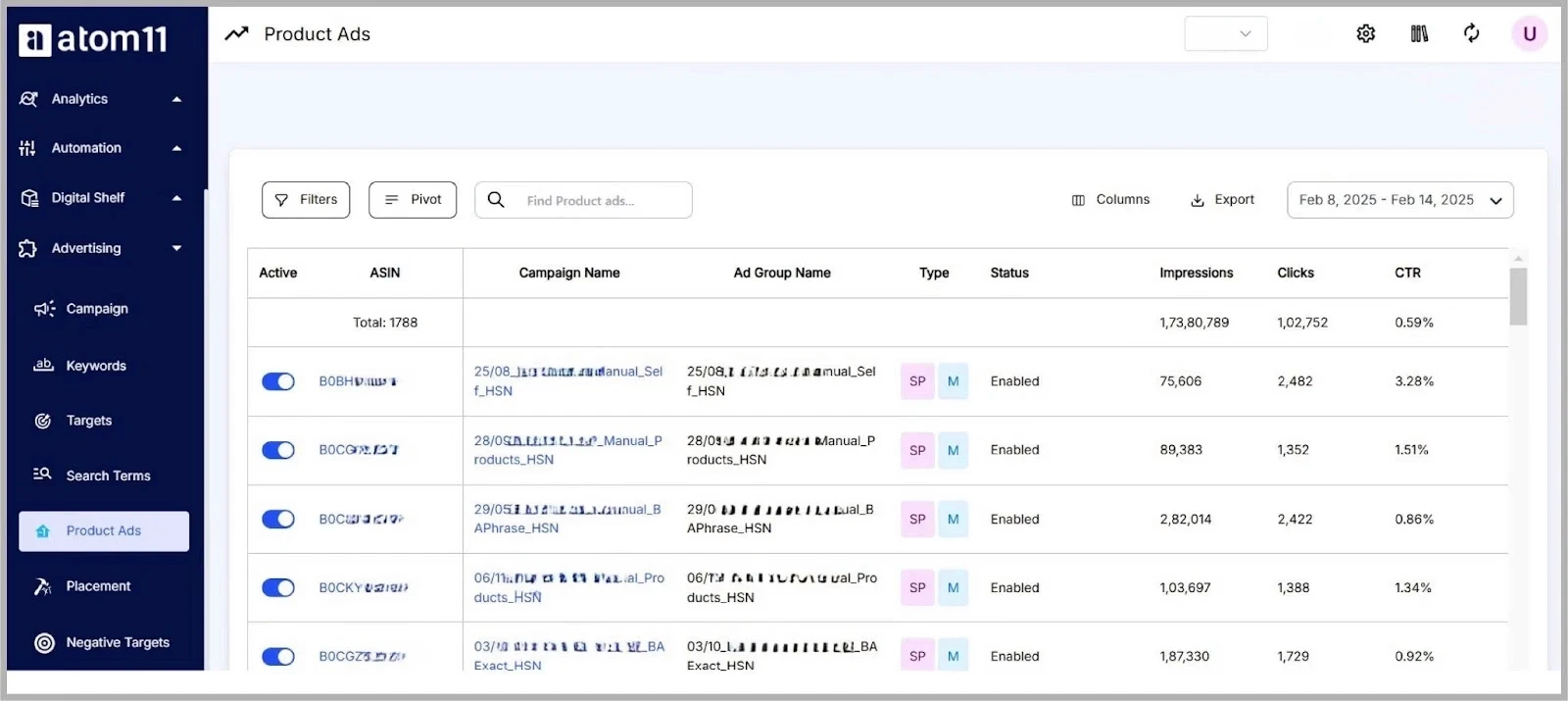
The Analytics Dashboard offers a comprehensive view of ad spend performance metrics, including Total Sales, Total Orders, Ad Spend, Ad CVR, ACoS, and TACoS. It presents an overview categorized by sales bands (Top, Medium, and Bottom sellers) and provides detailed ASIN-level insights on spending percentages. Additionally, it includes search term analysis that differentiates by keyword type, target type, and placement type.
The Advertising Dashboard serves as a central hub for tracking and analyzing all your PPC ads in one place. It offers comprehensive insights into campaign performance, helping sellers make data-driven decisions. A standout feature, Pivot, provides granular campaign-level performance metrics for each specific product, enabling precise optimizations.
Conclusion
Amazon ad placements are an important part of your advertising strategy that help drive sales, improve brand visibility, and maximize advertising efficiency. By setting clear goals, conducting thorough keyword research, leveraging placement multipliers, and continuously analyzing performance, you can gain a competitive edge on the platform and achieve sustained growth.
To optimize your ad placements for higher profitability, atom11 is here to help you.
Atom11, an Amazon PPC software, empowers sellers with insights and strategic bidding tools that help maximize returns and stay ahead in the competitive Amazon marketplace.
Want to streamline your Amazon ad strategies? Book a demo with atom11 today.
FAQs
Where are Amazon ads placed?
Amazon ads are placed in multiple locations, like the top of search on Amazon SERP, third-party websites, product detail pages, and more.
What is the best placement for ads?
The best ad placement depends on your goals. Product detail pages work best for cross-selling and competitor targeting, while top of search is ideal for conversions and high visibility.
Does ad placement matter?
Yes! Ad placements can impact ad performance and influence key metrics like conversion rates and overall ad efficiency. A strategic and optimized ad placement ensures you reach the right customers at the right place and the right time.
How much does it cost to place an ad on Amazon?
Amazon ads have been designed to work with any advertising budget. There is no minimum required spend for ad placements, which makes it easier to test the campaigns that work best for your business and budgets.
What is placement in Amazon ads?
Placement in Amazon ads refers to the specific locations where ads appear on Amazon's platform, such as search results, product detail pages, and third-party websites.
Where can Amazon Display Ads be placed?
Amazon Display Ads can be placed on Amazon product detail pages, search results, and on third-party websites and apps like Twitch.
Where do Amazon ads appear?
Amazon ads appear in multiple locations within Amazon’s ecosystem including the top of search results (Amazon SERP), rest of search pages, product detail pages, competitor listings, customer review pages, and on third-party websites and apps like Twitch, Buzzfeed, and ESPN.
Where are Amazon sponsored ads placements?
Amazon sponsored ads placements include the Top of Search, Rest of Search, and Product Detail Pages for Sponsored Products; top and bottom of search pages for Sponsored Brand ads; and product detail pages, customer review pages, and third-party sites/apps for Sponsored Display ads
How do ad placements work?
Ad placements determine where and when your ads appear within Amazon’s platform to influence shoppers’ buying decisions. Different placements target customers at various stages of the buying journey and affect key performance metrics like visibility, click through rate (CTR), and conversion rate (CVR). Understanding placements helps allocate budgets, optimize bids, and improve overall ad performance.
Where are Amazon Display ads placements?
Amazon Display ads placements appear on Amazon product detail pages (desktop and mobile), customer review pages, and across third-party websites and apps such as Twitch, Buzzfeed, and ESPN via Amazon Publisher Services.
Does Amazon ads charge for impressions or clicks?
Amazon ads operate on a pay-per-click (PPC) model, meaning advertisers only pay when a customer clicks on their ad not for impressions

